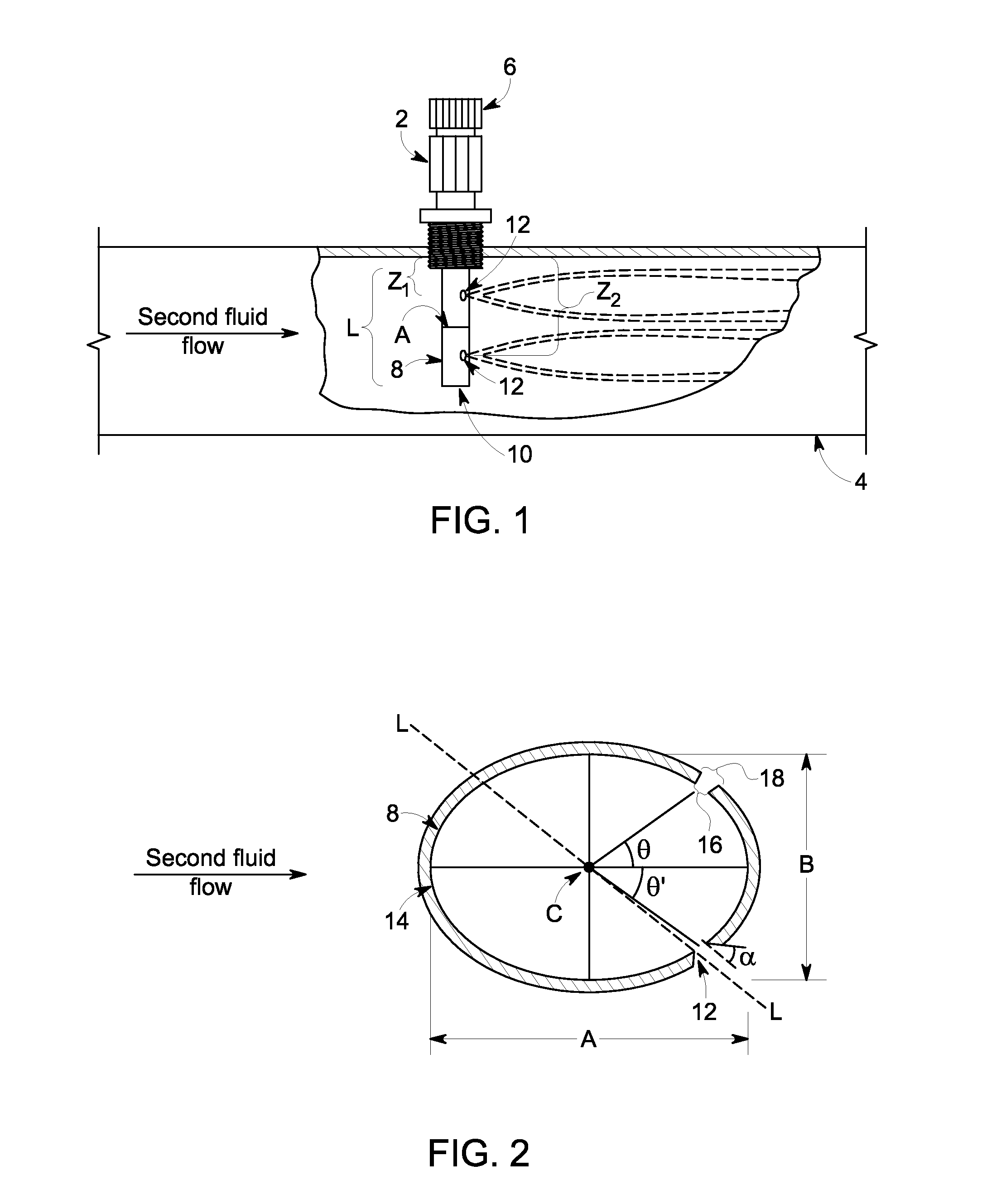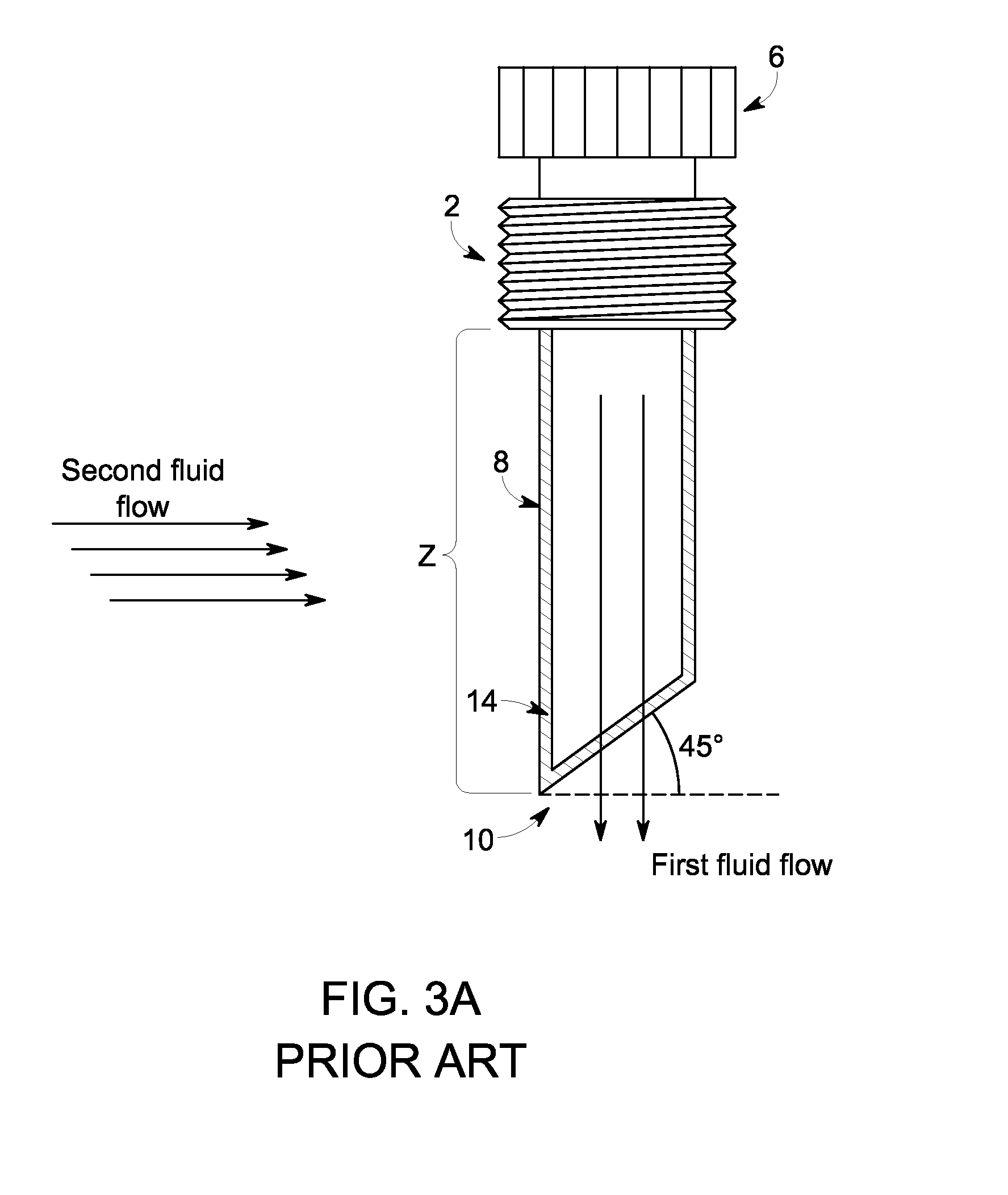Injection quill designs and methods of use
a technology of injection quills and quills, which is applied in the direction of transportation and packaging, mixing, chemistry apparatus and processes, etc., can solve the problems of severe corrosion of exposed pipe surfaces, uneven coverage of processing equipment surfaces, and uneven distribution of treatment chemicals, so as to improve the coating process and improve the dispersion process , increase the volume fraction of the filmer
- Summary
- Abstract
- Description
- Claims
- Application Information
AI Technical Summary
Benefits of technology
Problems solved by technology
Method used
Image
Examples
examples
[0108]The injection quill designs may be used to coat a pipe wall with a filmer or to disperse a chemical treatment, such as a scavenger, in a hydrocarbon stream. When coating a pipe wall or other processing equipment, the coating process may be improved by increasing the volume fraction of the filmer (“first fluid”) on the pipe walls along the length of the pipe. Thus, the volume fraction (VF) of naphtha was evaluated using different quill designs. When dispersing a chemical treatment throughout a process stream, the dispersion process may be improved by minimizing the decrease in velocity of the process stream being treated (“second fluid”) caused by the stem and when injecting the first fluid. Thus, the fluid velocity was also evaluated using different quill designs.
[0109]For the examples, the effects of location angle θ, the chamfer angle (α), and the number of orifices, on volume fraction and fluid velocity were simulated using Computational Fluid Dynamics (“CFD”) model. Multip...
example set 1
Number of Orifices
[0111]Example Set 1 shows the effects of the number of orifices on the volume fraction of naphtha and velocity of the fluid in the pipe. The effects were simulated for a stem with two orifices and compared with a stem with four orifices. The inner diameter (16) of the orifice was ⅛″. The chamfer angle (α) was 60° and the chamfer length was 0.226″, the entire thickness of the stem sidewall (14). The orifice location angles θ and θ′ were 75° and −75° respectively for all the simulations in Example Set 1.
[0112]For the simulations with two orifices, the distance (z) for the two orifices was 12″ from the pipe wall. For the simulations with four orifices, the distance (z1) for the first orifice pair was six inches from the pipe wall and the distance (z2) for the second orifice pair was 12 inches from the pipe wall. The data for the two-orifice and four-orifice simulations are summarized in Table 1 below.
TABLE 1volumetricflow rationatural gasnatural(naphtha / locationnaphth...
example set 2
Chamfer Angle
[0114]Example Set 2 shows the effects of the chamfer angle (α) on the volume fraction (VF) of naphtha and velocity of the fluid in the pipe. The effects were simulated for a stem with one orifice located at θ=0° and z=12″. The inner diameter (16) of the orifice was ⅛″ and stem sidewall (14) thickness was 0.226″. The chamfer length was the entire thickness of the stem sidewall, i.e., 0.226″. The chamfer angles (α) tested were 7.3°, 30°, 60°, and 70°. The data for the chamfer angle simulations are summarized in Table 2 below.
TABLE 2volumetricflow rationatural gasnaphthanatural gas(naphtha / locationnaphthavelocityFRFRnatural(m)VF(m / s)(kg / s)(kg / s)gas)α = 7.3°; Naphtha Volume Fractionon Pipe Wall = 1.97E−11x = 3.073.15E−0619.11.95E−095.30E−043.386E−09 x = 41.79E−0718.96.36E−071.10E−035.31E−07x = 51.77E−0719.08.81E−072.00E−034.05E−07x = 61.74E−0718.92.07E−065.70E−033.34E−07x = 71.73E−0718.92.03E−066.80E−032.74E−07x = 81.72E−0718.92.29E−067.80E−032.70E−07x = 91.72E−0719.01.95E−...
PUM
| Property | Measurement | Unit |
|---|---|---|
| chamfer angle | aaaaa | aaaaa |
| chamfer angle | aaaaa | aaaaa |
| chamfer angle | aaaaa | aaaaa |
Abstract
Description
Claims
Application Information
 Login to View More
Login to View More - R&D
- Intellectual Property
- Life Sciences
- Materials
- Tech Scout
- Unparalleled Data Quality
- Higher Quality Content
- 60% Fewer Hallucinations
Browse by: Latest US Patents, China's latest patents, Technical Efficacy Thesaurus, Application Domain, Technology Topic, Popular Technical Reports.
© 2025 PatSnap. All rights reserved.Legal|Privacy policy|Modern Slavery Act Transparency Statement|Sitemap|About US| Contact US: help@patsnap.com



